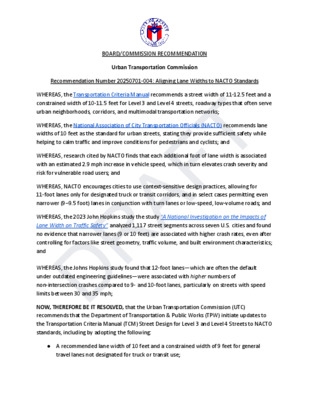04 Draft Recommendation - Aligning Lane Widths to NACTO Standards — original pdf
Backup

BOARD/COMMISSION RECOMMENDATION Urban Transportation Commission Recommendation Number 20250701-004: Aligning Lane Widths to NACTO Standards WHEREAS, the Transportation Criteria Manual recommends a street width of 11-12.5 feet and a constrained width of 10-11.5 feet for Level 3 and Level 4 streets, roadway types that often serve urban neighborhoods, corridors, and multimodal transportation networks; WHEREAS, the National Association of City Transportation Officials (NACTO) recommends lane widths of 10 feet as the standard for urban streets, stating they provide sufficient safety while helping to calm traffic and improve conditions for pedestrians and cyclists; and WHEREAS, research cited by NACTO finds that each additional foot of lane width is associated with an estimated 2.9 mph increase in vehicle speed, which in turn elevates crash severity and risk for vulnerable road users; and D R A F T WHEREAS, NACTO encourages cities to use context-sensitive design practices, allowing for 11-foot lanes only for designated truck or transit corridors, and in select cases permitting even narrower (9–9.5 foot) lanes in conjunction with turn lanes or low-speed, low-volume roads; and WHEREAS, the 2023 John Hopkins study the study “A National Investigation on the Impacts of Lane Width on Traffic Safety” analyzed 1,117 street segments across seven U.S. cities and found no evidence that narrower lanes (9 or 10 feet) are associated with higher crash rates, even after controlling for factors like street geometry, traffic volume, and built environment characteristics; and WHEREAS, the Johns Hopkins study found that 12-foot lanes—which are often the default under outdated engineering guidelines—were associated with higher numbers of non-intersection crashes compared to 9- and 10-foot lanes, particularly on streets with speed limits between 30 and 35 mph; NOW, THEREFORE BE IT RESOLVED, that the Urban Transportation Commission (UTC) recommends that the Department of Transportation & Public Works (TPW) initiate updates to the Transportation Criteria Manual (TCM) Street Design for Level 3 and Level 4 Streets to NACTO standards, including by adopting the following: ● A recommended lane width of 10 feet and a constrained width of 9 feet for general travel lanes not designated for truck or transit use; ● A recommended width of 11 feet and constrained width of 10 feet for general travel lanes with transit use or where freight/delivery traffic is expected to be greater than 10% of total traffic; and ● The inclusion of contextual factors that would require a lane width greater than 11 feet; and BE IT FURTHER RESOLVED, that the UTC recommends that TPW consider, as current resources allow, conducting a lane width audit on City of Austin Level 3 & 4 Streets to identify roadways where excessive lane widths may create a safety issue, and prioritize those streets for restriping, resurfacing, or other improvements; and BE IT FURTHER RESOLVED, that the UTC recommends the City Council amend the Austin Strategic Mobility Plan to include target indicators for lane width reduction under Chapter 1, “Designing for Safety.” D R A F T Attest: _____________________________________________ (Staff or board member can sign) Motioned by: Seconded by: Date of Approval: Record of the vote: